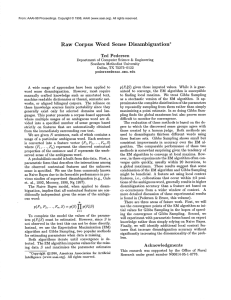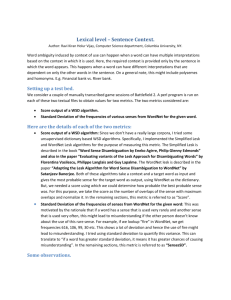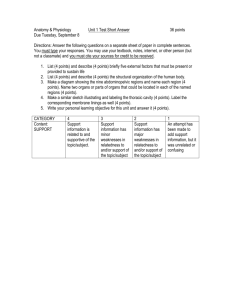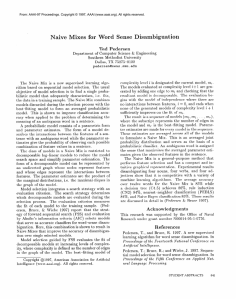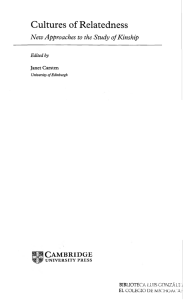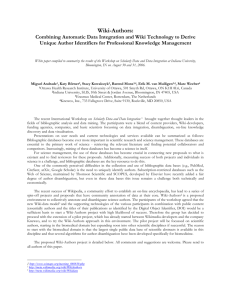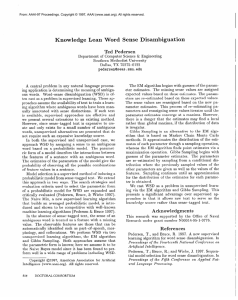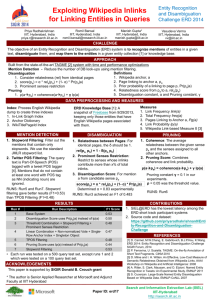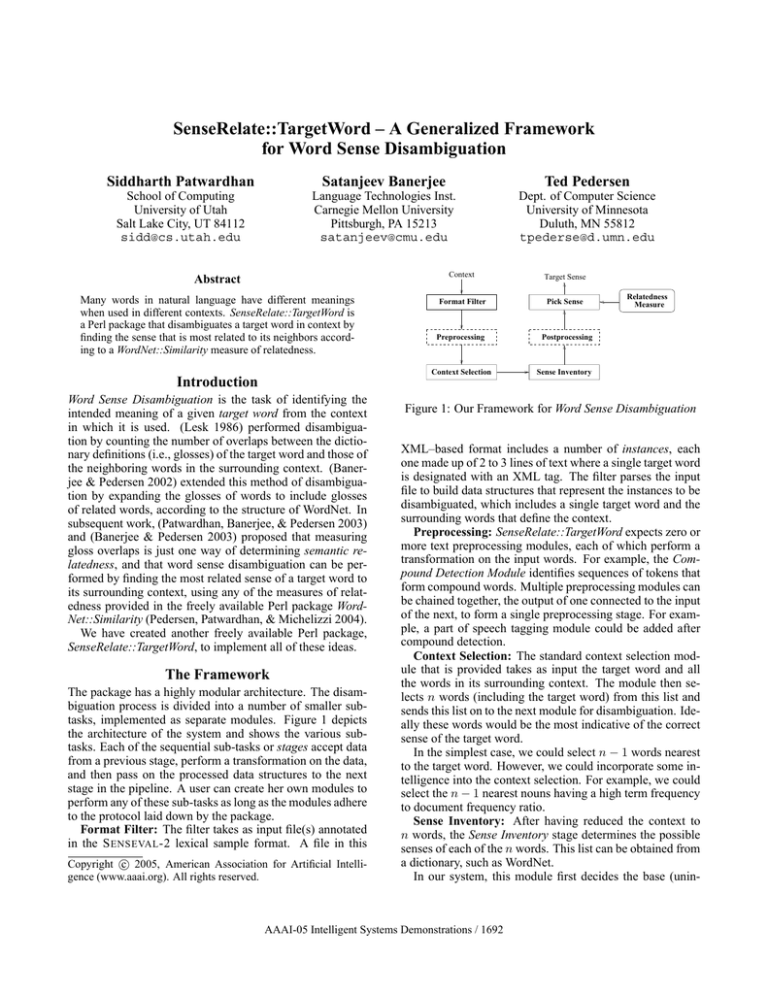
SenseRelate::TargetWord – A Generalized Framework
for Word Sense Disambiguation
Siddharth Patwardhan
Satanjeev Banerjee
Ted Pedersen
School of Computing
University of Utah
Salt Lake City, UT 84112
sidd@cs.utah.edu
Language Technologies Inst.
Carnegie Mellon University
Pittsburgh, PA 15213
satanjeev@cmu.edu
Dept. of Computer Science
University of Minnesota
Duluth, MN 55812
tpederse@d.umn.edu
Abstract
Context
Target Sense
Many words in natural language have different meanings
when used in different contexts. SenseRelate::TargetWord is
a Perl package that disambiguates a target word in context by
finding the sense that is most related to its neighbors according to a WordNet::Similarity measure of relatedness.
Format Filter
Pick Sense
Preprocessing
Postprocessing
Context Selection
Relatedness
Measure
Sense Inventory
Introduction
Word Sense Disambiguation is the task of identifying the
intended meaning of a given target word from the context
in which it is used. (Lesk 1986) performed disambiguation by counting the number of overlaps between the dictionary definitions (i.e., glosses) of the target word and those of
the neighboring words in the surrounding context. (Banerjee & Pedersen 2002) extended this method of disambiguation by expanding the glosses of words to include glosses
of related words, according to the structure of WordNet. In
subsequent work, (Patwardhan, Banerjee, & Pedersen 2003)
and (Banerjee & Pedersen 2003) proposed that measuring
gloss overlaps is just one way of determining semantic relatedness, and that word sense disambiguation can be performed by finding the most related sense of a target word to
its surrounding context, using any of the measures of relatedness provided in the freely available Perl package WordNet::Similarity (Pedersen, Patwardhan, & Michelizzi 2004).
We have created another freely available Perl package,
SenseRelate::TargetWord, to implement all of these ideas.
The Framework
The package has a highly modular architecture. The disambiguation process is divided into a number of smaller subtasks, implemented as separate modules. Figure 1 depicts
the architecture of the system and shows the various subtasks. Each of the sequential sub-tasks or stages accept data
from a previous stage, perform a transformation on the data,
and then pass on the processed data structures to the next
stage in the pipeline. A user can create her own modules to
perform any of these sub-tasks as long as the modules adhere
to the protocol laid down by the package.
Format Filter: The filter takes as input file(s) annotated
in the S ENSEVAL -2 lexical sample format. A file in this
c 2005, American Association for Artificial IntelliCopyright gence (www.aaai.org). All rights reserved.
Figure 1: Our Framework for Word Sense Disambiguation
XML–based format includes a number of instances, each
one made up of 2 to 3 lines of text where a single target word
is designated with an XML tag. The filter parses the input
file to build data structures that represent the instances to be
disambiguated, which includes a single target word and the
surrounding words that define the context.
Preprocessing: SenseRelate::TargetWord expects zero or
more text preprocessing modules, each of which perform a
transformation on the input words. For example, the Compound Detection Module identifies sequences of tokens that
form compound words. Multiple preprocessing modules can
be chained together, the output of one connected to the input
of the next, to form a single preprocessing stage. For example, a part of speech tagging module could be added after
compound detection.
Context Selection: The standard context selection module that is provided takes as input the target word and all
the words in its surrounding context. The module then selects n words (including the target word) from this list and
sends this list on to the next module for disambiguation. Ideally these words would be the most indicative of the correct
sense of the target word.
In the simplest case, we could select n − 1 words nearest
to the target word. However, we could incorporate some intelligence into the context selection. For example, we could
select the n − 1 nearest nouns having a high term frequency
to document frequency ratio.
Sense Inventory: After having reduced the context to
n words, the Sense Inventory stage determines the possible
senses of each of the n words. This list can be obtained from
a dictionary, such as WordNet.
In our system, this module first decides the base (unin-
AAAI-05 Intelligent Systems Demonstrations / 1692
flected) form of each of the n words. It then retrieves all
the senses for each word from the sense inventory. We use
WordNet for our sense inventory.
Postprocessing: Some optional processing can be performed on the data structures generated by the Sense Inventory module. This would include tasks such as sense pruning, which is the process of removing some senses from the
inventory, based on simple heuristics, algorithms or options.
For example, the user may decide to preclude all verb senses
of the target word from further consideration in the disambiguation process.
Sense Selection: The disambiguation module takes the
lists of senses of the target word and those of the context
words and uses this information to pick one sense of the target word as the answer. Many different algorithms could be
used to do this. We have modules Local and Global that
(in different ways) determine the relatedness of each of the
senses of the target word with those of the context words,
and pick the most related sense as the answer. These are
described in greater detail by (Banerjee & Pedersen 2002).
Using SenseRelate::TargetWord
SenseRelate::TargetWord can be used via the command-line
interface (disamb.pl), a graphical interface, as well as a programming API.
The command-line interface disamb.pl takes as input a
S ENSEVAL -2 formatted lexical sample file. The program
disambiguates the marked up word in each instance and outputs the instance ID, along with the disambiguated sense of
the target word. Many command line options are available
to control the disambiguation process.
SenseRelate::TargetWord is distributed as a Perl package.
It is programmed in object-oriented Perl as a group of Perl
classes. Objects of these classes can be instantiated in user
programs, and methods can be called on these objects.
We are currently developing a graphical interface for the
package in order to conveniently access the disambiguation
modules. The GUI is being written in Gtk-Perl – a Perl API
to the Gtk toolkit. Unlike the command line interface, the
graphical interface will not be tied to any input file format.
The interface will allow the user to input text, and to select
the word to disambiguate.
Related Work
One of the first approaches to Word Sense Disambiguation
that used dictionary content was (Lesk 1986), which treated
every dictionary definition of a concept as a bag of words.
To identify the intended sense of the target word, the Lesk
algorithm would determine the number of word overlaps between the definitions of each of the meanings of the target
word, and those of the context words. The meaning of the
target word with maximum definition overlap with the context words was selected as the intended sense.
(Wilks et al. 1993) developed a context vector approach
for performing word sense disambiguation. Their algorithm
built co-occurrence vectors from dictionary definitions using
Longman’s Dictionary of Contemporary English (LDOCE).
They then determined the extent of overlap between the sum
of the vectors of the words in the context and the sum of the
vectors of the words in each of the definitions (of the target
word). For vectors, the extent of overlap is defined as the
dot product of the vectors. The meaning of the target word
that had the maximum overlap was selected as the answer.
More recently, (McCarthy et al. 2004) present a method
that performs disambiguation by determing the most frequent sense of a word in a particular domain. This is
based on measuring the relatedness of the different possible senses of a target word (using WordNet::Similarity) to a
set of words associated with a particular domain that have
been identified using distributional methods. The relatedness scores between a target word and the members of this
set are scaled by the distributional similarity score.
Acknowledgements
This research is partially supported by a National Science
Foundation Faculty Early CAREER Development Award
(#0092784).
SenseRelate::TargetWord is written in Perl and is freely
distributed via the Gnu General Public License. It is
available via SourceForge, an Open Source development
platform1 , and the Comprehensive Perl Archive Network
(CPAN)2 .
References
Banerjee, S., and Pedersen, T. 2002. An adapted Lesk
algorithm for word sense disambiguation using WordNet.
In Proceedings of the Third International Conference on
Intelligent Text Processing and Computational Linguistics.
Banerjee, S., and Pedersen, T. 2003. Extended gloss overlaps as a measure of semantic relatedness. In Proceedings
of the Eighteenth International Joint Conference on Artificial Intelligence (IJCAI-03).
Lesk, M. 1986. Automatic sense disambiguation using machine readable dictionaries: How to tell a pine cone from
an ice cream cone. In Proceedings of SIGDOC ’86.
McCarthy, D.; Koeling, R.; Weeds, J.; and Carroll, J. 2004.
Finding predominant word senses in untagged text. In Proceedings of the 42nd Meeting of the Association for Computational Linguistics (ACL-04).
Patwardhan, S.; Banerjee, S.; and Pedersen, T. 2003. Using measures of semantic relatedness for word sense disambiguation. In Proceedings of the Fourth International
Conference on Intelligent Text Processing and Computational Linguistics (CICLING-03).
Pedersen, T.; Patwardhan, S.; and Michelizzi, J. 2004.
Wordnet::Similarity - measuring the relatedness of concepts. In Proceedings of the Nineteenth National Conference on Artificial Intelligence (AAAI-04).
Wilks, Y.; Fass, D.; Guo, C.; McDonald, J.; Plate, T.; and
Slator, B. 1993. Providing machine tractable dictionary
tools. In Pustejovsky, J., ed., Semantics and the Lexicon.
Dordrecht and Boston: Kluwer Academic Press.
1
2
http://senserelate.sourceforge.net
http://search.cpan.org/dist/WordNet-SenseRelate-TargetWord
AAAI-05 Intelligent Systems Demonstrations / 1693

